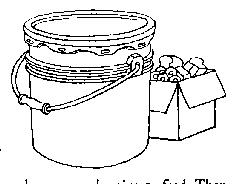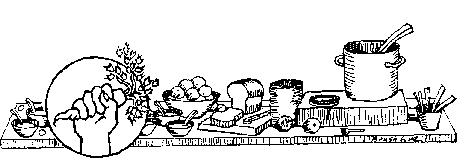
| Contents | Start | Previous | Next |
Since most Food Not Bombs groups do some amount of cooking outdoors, it is a good idea to acquire a camp stove. Propane seems to be the best fuel for cooking in field kitchens. The tanks can be refilled, and even the smaller ones last a long time on one filling. It is worth while to obtain a strong, heavy-duty stove, and while that might cost more, it will last longer and be safer with large pots. This and all the other equipment needed for food preparation and serving can be obtained from restaurant supply stores, thrift stores, yard sales, kitchen auctions, and friends. (See Equipment List in the Recipes section for more details.)
In general, the most important pieces of equipment are the cooking pots. You will need all different sizes, but the most valuable are the very large pots of 40 quarts or more. A couple of hundred people generally can be fed from a pot this size, depending on what is prepared in it, but these pots are hard to come by. Most people who have pots this size will not loan them out. The cheapest pots to buy are aluminum, but we discourage their use because of toxicity. If you must use aluminum pots, never prepare miso or tomato-based recipes in them -- the aluminum will corrode and leach into the food. Try to have stainless-steel pots donated to you, and once you have a collection of pots and lids, be very careful with them. It is not uncommon to lose pots between the kitchen and the vehicle or between the vehicle and the serving table. Also, try to avoid having the pots in a situation that might lead to arrest. Transfer the food into smaller, less valuable pots or plastic buckets for these times.
Another valuable piece of equipment is the 5-gallon plastic bucket. These can usually be obtained free from natural food stores and co-ops. Ask them to save and give you peanut-butter buckets, tofu buckets, and other large plastic containers in which food is delivered and that they do not need or have to return. Don't forget to collect the lids, too. These containers are valuable for food storage, transportation, and serving, and they can also be used for many other purposes. Because they are fairly easy to get, they are also good to use in situations where you cannot be sure they will be returned to you.

Food Preparation
The major issue to address when considering how to prepare food at low cost for large numbers of people is one of logistics. Getting the proper amount of food, the necessary equipment, a suitable kitchen, and the cooking team all together at the same time might sometimes seem like a miracle, but it can be done. Each local chapter will develop its own method of food preparation; the following is a general guide.
The volunteer cooking team usually meets at the kitchen a few hours before the meal is scheduled to be served. They often help unload the food and equipment from the Food Not Bombs vehicle. Always wash your hands with soap before cooking, and plan the menu by looking at what food you have and how many people you are planning to feed i nen sort out all the useful food and wash it. (The most time-consuming job in this process is washing and cutting the vegetables.)

| Contents | Start | Previous | Next |